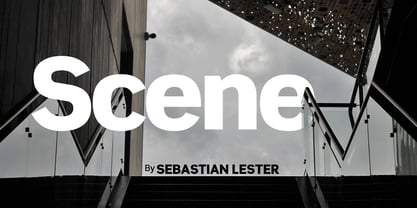Seleccione este tipo de licencia cuando esté desarrollando una aplicación app para iOS, Android o Windows Phone, y vaya a incrustar el archivo en el código de su aplicación móvil. va a incrustar el archivo fuente en el código de su aplicación móvil.
Scene®
por Monotype
- Aa Glifos
-
¡Mejor PrecioPaquetes de familia
- Estilos individuales
- Especificaciones técnicas
- Licencias
Scene Complete Family Pack
12 fuentesPor estilo:
$34.99
Paquete de 12 estilos:
$419.99
Scene Complete Family Pack
12 fuentesPor estilo:
$34.99
Paquete de 12 estilos:
$419.99
Sobre la familia Scene Fuente
El trabajo en Scene comenzó algún tiempo después de que el diseñador Sebastian Lester se incorporara a Monotype Imaging en 2000. Limpio, tranquilo y muy legible: así eran las instrucciones de diseño que Lester se impuso a sí mismo. Con Scene, quería proporcionar a los diseñadores gráficos y directores creativos un conjunto de fuentes que sirviera de base sólida para los proyectos de identidad, incorporando lo que había aprendido sobre la legibilidad en pantalla e impresa. Scene se desarrolló durante dos años de trabajo a deshoras y en fines de semana. La familia se presenta en seis pesos con cursivas a juego, y hay un conjunto de caracteres "semi-sans" para introducir ritmos de palabra más expresivos en titulares y bloques de texto.
Diseñadores: Sebastian Lester
Editorial: Monotype
Fundición: Monotype
Propietario del diseño: Monotype
MyFonts debut: 13 de octubre de 2005

Acerca de Monotype
La Biblioteca Monotype es una de las mayores y más completas colecciones de tipos de letra del mundo, con diseños originales de importancia histórica y una nueva gama de diseños contemporáneos y de moda fuentes. La Biblioteca Monotype incluye miles de clásicos atemporales, revivals artesanales y diseños originales de muchos de los diseñadores tipográficos y fundiciones más innovadores de la historia. Esta biblioteca distintiva y galardonada de primera calidad fuentes ofrece a marcas y diseñadores una selección amplia y fiable de tipos de letra para una tipografía expresiva en impresión y en pantalla. La página de la Fundición Premium puede consultarse aquí.
Seguir leyendo
Leer menos